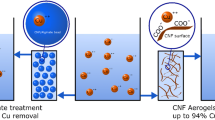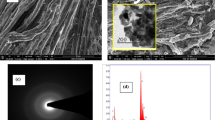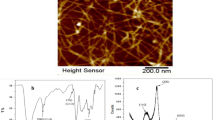Abstract
Mercury contamination in drinking water is a worldwide problem due to its severely harming effects on the human body. A nanostructured natural bioadsorbent, carboxycellulose nanofiber extracted from raw moringa plant using the nitro-oxidation method (termed NOCNF), capable of effectively remediating this problem has been demonstrated. Nitro-oxidation is a simple approach that can extract carboxylated nanocellulose directly from raw biomass. In this study, the produced NOCNF contained a large density of carboxylate groups on the cellulose surface (0.97 mmol/g), capable of removing Hg2+ ions by simultaneous electrostatic-interactions and mineralization processes. Using the Langmuir analysis, the adsorption results indicated that the highest Hg2+ removal capacity of this NOCNF was 257.07 mg/g, which is higher than most of the reported values. The interactions between Hg2+ and NOCNF were further characterized by Fourier-transform infrared spectroscopy, scanning electron microscopy/energy dispersive spectroscopy (SEM/EDS), transmission electron microscopy with electron diffraction and wide-angle X-ray diffraction methods, suggesting the existence of two distinct removal mechanisms: predominant adsorption at low Hg2+concentrations (< 250 ppm) and predominant mineralization at high Hg2+ concentrations (> 1000 ppm). The applications of NOCNF were illustrated in both suspension form, as an adsorbent/coagulant, and dry powder form using filtration column. The results indicated that NOCNF in suspension exhibited a higher maximum removal efficiency of 81.6% as compared to the dry state of 74.3%. This work demonstrated the feasibility of extracting nanostructured adsorbents from biomass feedstocks to tackle the Hg2+ contamination problem in drinking water.
Graphic abstract
Cellulose nanofibers, extracted from Moringa plant using the nitro-oxidation method, exhibit excellent adsorption capacity for Mercury (II) removal.









Similar content being viewed by others
Data availability
The experimental data and materials are available upon request.
References
Anbia M, Amirmahmoodi S (2016) Removal of Hg (II) and Mn (II) from aqueous solution using nanoporous carbon impregnated with surfactants. Arabian J Chem 9:S319–S325. https://doi.org/10.1016/j.arabjc.2011.04.004
Anoop Krishnan K, Anirudhan TS (2002) Removal of mercury(II) from aqueous solutions and chlor-alkali industry effluent by steam activated and sulphurised activated carbons prepared from bagasse pith: kinetics and equilibrium studies. J Hazard Mater 92:161–183. https://doi.org/10.1016/S0304-3894(02)00014-6
Baeyens W, Ebinghaus R, Vasiliev O (2012) Global and regional mercury cycles: sources, fluxes and mass balances. Springer, Berlin
Chen H, Sunil KS, Priyanka RS, Heidi Y, Ken J, Benjamin SH (2019) Arsenic(III) removal by nanostructured dialdehyde cellulose–cysteine microscale and nanoscale fibers. ACS Omega 4:22008–22020. https://doi.org/10.1021/acsomega.9b03078
Chi K, Jeffrey MC (2017) The influences of added polysaccharides on the properties of bacterial crystalline nanocellulose. Nanoscale 9:15144–15158. https://doi.org/10.1039/C7NR05615J
Chiarle S, Ratto M, Rovatti M (2000) Mercury removal from water by ion exchange resins adsorption. Water Res 34:2971–2978. https://doi.org/10.1016/S0043-1354(00)00044-0
Cui G, Min L, Ying C, Wei Z, Jiangqi Z (2016) Synthesis of a ferric hydroxide-coated cellulose nanofiber hybrid for effective removal of phosphate from wastewater. Carbohydr Polym 154:40–47. https://doi.org/10.1016/j.carbpol.2016.08.025
Di Natale F, Erto A, Lancia A, Musmarra D (2011) Mercury adsorption on granular activated carbon in aqueous solutions containing nitrates and chlorides. J Hazard Mater 192:1842–1850. https://doi.org/10.1016/j.jhazmat.2011.07.021
Guo YF, Zhuo W, Zhou X, Renbi B (2017) Removal of mercury (II) from aqueous solution with three commercial raw activated carbons. Res Chem Intermed 43:2273–2297. https://doi.org/10.1007/s11164-016-2761-y
Harada M (1995) Minamata disease: methylmercury poisoning in Japan caused by environmental pollution. Crit Rev Toxicol 25:1–24. https://doi.org/10.3109/10408449509089885
Kalibbala HM, Olle W, Hawumba TJ (2009) The impact of Moringa oleifera as a coagulant aid on the removal of trihalomethane (THM) precursors and iron from drinking water. Water Sci Technol Water Supply 9:707–714. https://doi.org/10.2166/ws.2009.671
Kim JH, Bong SS, Heung SK, Lee YJ, Min SK, Daseul J, Zafar A, Jaehwan K (2015) Review of nanocellulose for sustainable future materials. Int J Precis Eng Manuf Green Technol 2:197–213. https://doi.org/10.1007/s40684-015-0024-9
Lai EP, Wong B, Vandernoot VA (1993) Preservation of solid mercuric dithizonate samples with polyvinyl chloride for determination of mercury(II) in environmental waters by photochromism-induced photoacoustic spectrometry. Talanta 40:1097–1105. https://doi.org/10.1016/0039-9140(93)80172-N
Larson KA, John MW (1992) Liquid ion exchange for mercury removal from water over a wide pH range. Ind Eng Chem Res 31:2714–2722. https://doi.org/10.1021/ie00012a013
Liu P, Kristiina O, Aji PM (2016) Surface adsorption and self-assembly of Cu(II) ions on TEMPO-oxidized cellulose nanofibers in aqueous media. J Colloid Interface Sci 464:175–182. https://doi.org/10.1016/j.jcis.2015.11.033
Masruchin N, Kurniawan Y, Sukma K, Putri A, Lisman S, Arif N (2019) TEMPO-mediated oxidation cellulose pulp modified with Monosodium Glutamate (MSG). IOP Conf Ser Earth Environ Sci 374:012010. https://doi.org/10.1088/1755-1315/374/1/012010
Melesse A, Berihun K (2013) Chemical and mineral compositions of pods of Moringa stenopetala and Moringa oleifera cultivated in the lowland of Gamogofa Zone. J Environ Occup Sci 2:33–38. https://doi.org/10.5455/jeos.20130212090940
Mohadesi A, Mehdi R, Hosseinpour-Mashkani SM (2014) Solvent-free synthesis of mercury oxide nanoparticles by a simple thermal decomposition method. Superlattices Microstruct 66:48–53. https://doi.org/10.1016/j.spmi.2013.11.017
Nam KH, Sergio GS, Lawrence LT (2003) Mercury(II) adsorption from wastewaters using a thiol functional adsorbent. Ind Eng Chem Res 42:1955–1964. https://doi.org/10.1021/ie020834l
Ornaghi J, Heitor L, Ademir JZ, Sandro CA (2014) Thermal behavior and the compensation effect of vegetal fibers. Cellulose 21:189–201. https://doi.org/10.1007/s10570-013-0126-x
Puanngam M, Unob F (2008) Preparation and use of chemically modified MCM-41 and silica gel as selective adsorbents for Hg(II) ions. J Hazard Mater 154:578–587. https://doi.org/10.1016/j.jhazmat.2007.10.090
Rio S, Delebarre A (2003) Removal of mercury in aqueous solution by fluidized bed plant fly ash. Fuel 82:153–159. https://doi.org/10.1016/S0016-2361(02)00237-5
Sajjadi SA, Alireza M, Hai NT, Ioannis A, Guilherme LD, Zorica RL, Selvaraju S, Abolfazl RS, Andrei I, Ahmad HB (2018) Efficient mercury removal from wastewater by pistachio wood wastes-derived activated carbon prepared by chemical activation using a novel activating agent. J Environ Manag 223:1001–1009. https://doi.org/10.1016/j.jenvman.2018.06.077
Sehaqui H, Andreas M, Uxua PL, Numa P, Philippe T, Tanja Z (2016) Cationic cellulose nanofibers from waste pulp residues and their nitrate, fluoride, sulphate and phosphate adsorption properties. Carbohydr Polym 135:334–340. https://doi.org/10.1016/j.carbpol.2015.08.091
Sharma PR, Aurnov C, Chengbo Z, Sunil KS, Lihong G, Benjamin SH (2018a) Lead removal from water using carboxycellulose nanofibers prepared by nitro-oxidation method. Cellulose 25:1961–1973. https://doi.org/10.1007/s10570-018-1659-9
Sharma PR, Aurnov C, Sunil KS, Lihong G, Nasim A, Darren M, Benjamin SH (2018b) Nanocellulose from spinifex as an effective adsorbent to remove Cadmium(II) from water. ACS Sustain Chem Eng 6:3279–3290. https://doi.org/10.1021/acssuschemeng.7b03473
Sharma PR, Aurnov C, Sunil KS, Benjamin SH (2017a) Efficient removal of UO22+ from water using carboxycellulose nanofibers prepared by the Nitro-Oxidation method. Ind Eng Chem Res 56:13885–13893. https://doi.org/10.1021/acs.iecr.7b03659
Sharma PR, Ritika J, Sunil KS, Benjamin SH (2017b) A simple approach to prepare carboxycellulose nanofibers from untreated biomass. Biomacromol 18:2333–2342. https://doi.org/10.1021/acs.biomac.7b00544
Sharma PR, Sunil KS, William B, Hui C, Benjamin SH (2020a) Remediation of UO22+from water by Nitro-Oxidized carboxycellulose nanofibers: performance and mechanism. In: Contaminants in our water: identification and remediation methods. ACS, pp 269–283. https://doi.org/10.1021/bk-2020-1352.ch013
Sharma PR, Varma AJ (2014a) Functionalized celluloses and their nanoparticles: morphology, thermal properties, and solubility studies. Carbohydr Polym 104:135–142. https://doi.org/10.1016/j.carbpol.2014.01.015
Sharma PR, Varma AJ (2014b) Thermal stability of cellulose and their nanoparticles: effect of incremental increases in carboxyl and aldehyde groups. Carbohydr Polym 114:339–343. https://doi.org/10.1016/j.carbpol.2014.08.032
Sharma PR, Bingqian Z, Sunil KS, Chengbo Z, Ruifu W, Surita RB, Benjamin SH (2018c) High aspect ratio carboxycellulose nanofibers prepared by Nitro-Oxidation method and their nanopaper properties. ACS Appl Nano Mater 1:3969–3980. https://doi.org/10.1021/acsanm.8b00744
Sharma SK, Priyanka RS, Hui C, Ken J, Chengbo Z, Ruifu W, Benjamin H (2020b) Cellulose-supported nanosized zinc oxide: highly efficient bionanomaterial for removal of arsenic from water. In: Contaminants in Our Water: Identification and Remediation Methods. ACS, pp 253–267. https://doi.org/10.1021/bk-2020-1352.ch012
Sharma SK, Priyanka RS, Simon L, Hui C, Ken J, Ruifu W, William B, Chengbo Z, Benjamin SH (2020c) Reinforcement of natural rubber latex using jute carboxycellulose nanofibers extracted using Nitro-Oxidation method. Nanomaterials 10:706. https://doi.org/10.3390/nano10040706
Skubal LR, Meshkov NK (2002) Reduction and removal of mercury from water using arginine-modified TiO2. J Photochem Photobiol A 148:211–214. https://doi.org/10.1016/S1010-6030(02)00045-X
Sluiter A, Hames B, Ruiz R, Scarlata C, Sluiter J, Templeton D, Crocker D (2010) Determination of structural carbohydrates and lignin in biomass. https://www.nrel.gov/docs/gen/fy13/42618.pdf. Issue Date: April 2008
Strojny EJ, Iwamasa RT, Ludo KF (1971) Oxidation of 2-methoxyethanol to methoxyacetic acid by nitric acid solutions. JACS 93:1171–1178. https://doi.org/10.1021/ja00734a024
Suman AK, Meeta G, Jain VK (2015) A novel reusable nanocomposite for complete removal of dyes, heavy metals and microbial load from water based on nanocellulose and silver nano-embedded pebbles. Environ Technol 36:706–714. https://doi.org/10.1080/09593330.2014.959066
Thakur VK, Voicu SI (2016) Recent advances in cellulose and chitosan based membranes for water purification: a concise review. Carbohydr Polym 146:148–165. https://doi.org/10.1016/j.carbpol.2016.03.030
Tran L, Pingxiao W, Yajie Z, Shuai L, Nengwu Z (2015) Comparative study of Hg(II) adsorption by thiol- and hydroxyl-containing bifunctional montmorillonite and vermiculite. Appl Surf Sci 356:91–101. https://doi.org/10.1016/j.apsusc.2015.08.038
Wang D (2019) A critical review of cellulose-based nanomaterials for water purification in industrial processes. Cellulose 26:687. https://doi.org/10.1007/s10570-018-2143-2
Wang JW, Kuo YM (2007) Preparation of fructose-mediated (polyethylene glycol/chitosan) membrane and adsorption of heavy metal ions. J Appl Polym Sci 105:1480–1489. https://doi.org/10.1002/app.26379
Wang R, Sihui G, Anna S, Xiao W, Zhe W, Rui Y, Benjamin SH, Benjamin C (2013) Nanofibrous microfiltration membranes capable of removing bacteria, viruses and heavy metal ions. J Membr Sci 446:376–382. https://doi.org/10.1016/j.memsci.2013.06.020
Wang X, Andrews L (2005) Infrared spectrum of Hg(OH)2 in solid neon and argon. Inorg Chem 44:108–113. https://doi.org/10.1021/ic048673w
Zabihi M, Ahmadpour A, Haghighi AA (2009) Removal of mercury from water by carbonaceous sorbents derived from walnut shell. J Hazard Mater 167:230–236. https://doi.org/10.1016/j.jhazmat.2008.12.108
Zhang FS, Jerome ON, Hideaki I (2005) Mercury removal from water using activated carbons derived from organic sewage sludge. Water Res 39:389–395. https://doi.org/10.1016/j.watres.2004.09.027
Zhang X, Zhihai Z, Guangjun R, Yan L, Shuang L, Bing Z, Zichen W (2013) Synthesis of lignin-modified silica nanoparticles from black liquor of rice straw pulping. Powder Technol 246:664–668. https://doi.org/10.1016/j.powtec.2013.06.034
Zhu C, Illia D, Jens R, Sven O, Allan H, Aji PM (2015) Adsorption behavior of cellulose and its derivatives toward Ag(I) in aqueous medium: an AFM, spectroscopic, and DFT study. Langmuir 31:12390–12400. https://doi.org/10.1021/acs.langmuir.5b03228
Acknowledgments
The financial support for this work was provided by a grant from the Polymer Program of the Division of Materials Science in the National Science Foundation (DMR-1808690). The authors thank Drs. Chung-Chueh Chang and Yuan Xue at the Advanced Energy Research and Technology Center in Stony Brook University for the assistance of the TGA, TEM and AFM measurements, and Ms. Katie Wooton at the Facility for Isotope Research and Student Training in Stony Brook University for the assistance of the ICP-MS analysis.
Funding
The financial support of this study is provided by the National Science Foundation (DMR-1808690).
Author information
Authors and Affiliations
Contributions
All authors contributed to the study conception and design. Materials were provided by NK and SC from Botswana Institute for Technology Research and Innovation; Material preparation, data collection and analysis were performed by HC and EF. The first draft of the manuscript was written by HC and all authors commented on previous versions of the manuscript. All authors read and approved the final manuscript; Authors have no conflicts of interest; Data and material are all transparent.
Corresponding authors
Ethics declarations
Conflict of interest
There are no conflicts of interest and competing interests among the authors of this study.
Additional information
Publisher's Note
Springer Nature remains neutral with regard to jurisdictional claims in published maps and institutional affiliations.
Supplementary information
Below is the link to the electronic supplementary material.
Rights and permissions
About this article
Cite this article
Chen, H., Sharma, S.K., Sharma, P.R. et al. Nitro-oxidized carboxycellulose nanofibers from moringa plant: effective bioadsorbent for mercury removal. Cellulose 28, 8611–8628 (2021). https://doi.org/10.1007/s10570-021-04057-5
Received:
Accepted:
Published:
Issue Date:
DOI: https://doi.org/10.1007/s10570-021-04057-5




